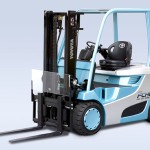
Fuel cells are devices that convert fuel into electricity using a chemical reaction involving oxygen or another oxidizing agent. Unlike batteries, fuel cells need constant supplies of the fuel and of oxygen. But as long as those are supplied, the fuel cell can produce electricity continually. The fuel they use might be hydrogen, natural gas or methanol.
The most famous early use of fuel cells was creating power for NASA space capsules, satellites and probes. Today they can be found in various commercial and industrial buildings, particularly in out-of-the-way or hard-to-access areas. Fuel cells can power virtually any vehicle, including cars, boats and forklifts. A recent article from Fuel Cell Today, published online at https://www.fuelcelltoday.com/ , poses the question of whether or not successful utilization of fuel cells in regions including the U.S. materials handling equipment industry will spread to other parts of the world.
“Can the success of fuel cell forklifts in the USA be replicated in other parts of the world?” asks the author, Dan Carter. Noting that 2011 data suggests that Europe has a 56% larger market for industrial trucks than the United States, Carter says that small differences – like lift truck models, operational voltage and batteries used per truck must be considered. The 2009 Recovery Act gave offsets to businesses to help fund purchases of fuel cells, but the article says companies including Sysco Foods and Walmart’s Canadian stores are “showing sustained interest in fuel cell technology” and “placing repeat orders with no government funding.”
Return on investment, of course, is a key to adopting alternative power supplies. Using hydrogen fuel cells can mean zero emissions – dependent on the hydrogen fuel source – and less business space used for changing batteries. The cells can also power materials handling equipment in controlled environmental conditions like freezing temperatures.
Carter writes that U.S. trucks often utilize as many as 2.5 batteries on average, while in Europe the number is less than 2. Productivity can be increased by fuel cell adoption. Normal battery exchanges for materials handling equipment take between 6 and 15 minutes, depending on the situation, but fuel cell-powered equipment can be refueled in under 3 minutes. “So if an operation has 50 forklifts, operating three shifts in a 24/7 manner and refuelling once per shift, the time savings are staggering,” Carter emphasizes with real-world examples. The Sysco Foods distribution facility in Houston, with fuel cells installed on a fleet of 98 lift trucks and pallet trucks, estimates that switching to fuel cells has saved the company 4800 worker-hours per year. Walmart’s distribution center in Balzac, Alberta, Canada has 95 fuel cells in its fleet, and the company estimates saving $1.1 million dollars over seven year while eliminating 530 metric tons of carbon dioxide emissions every year.
